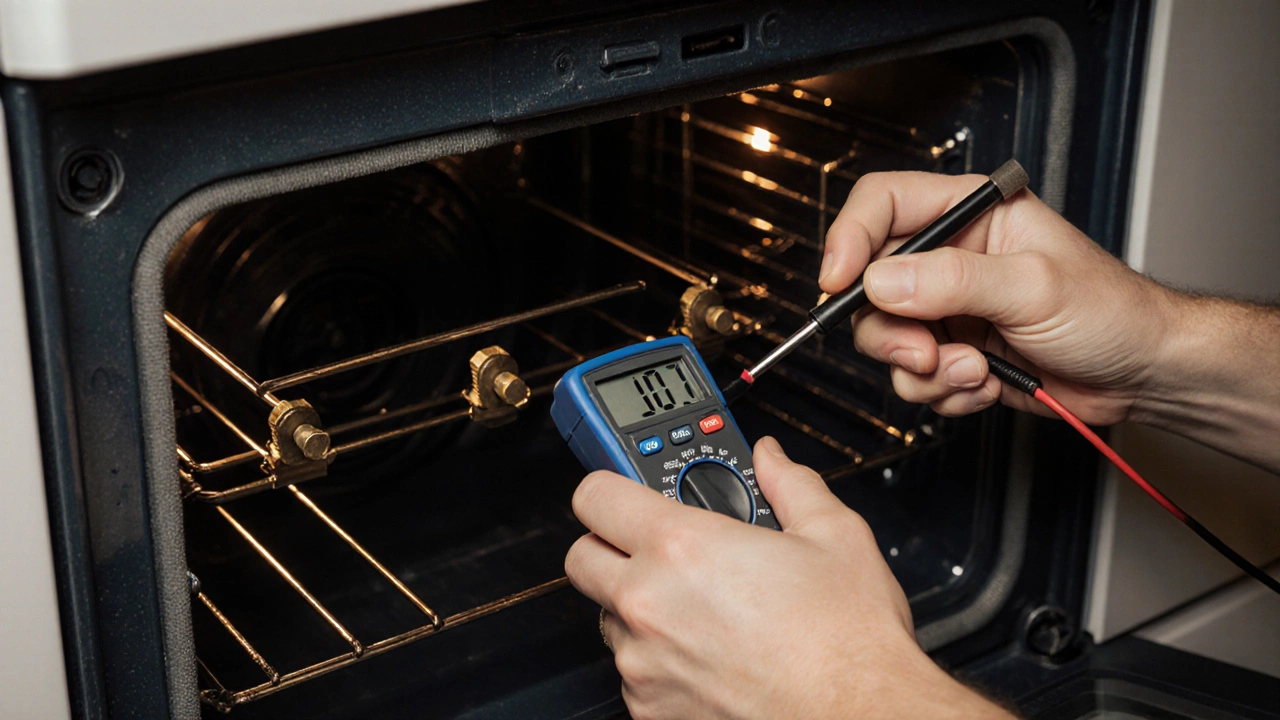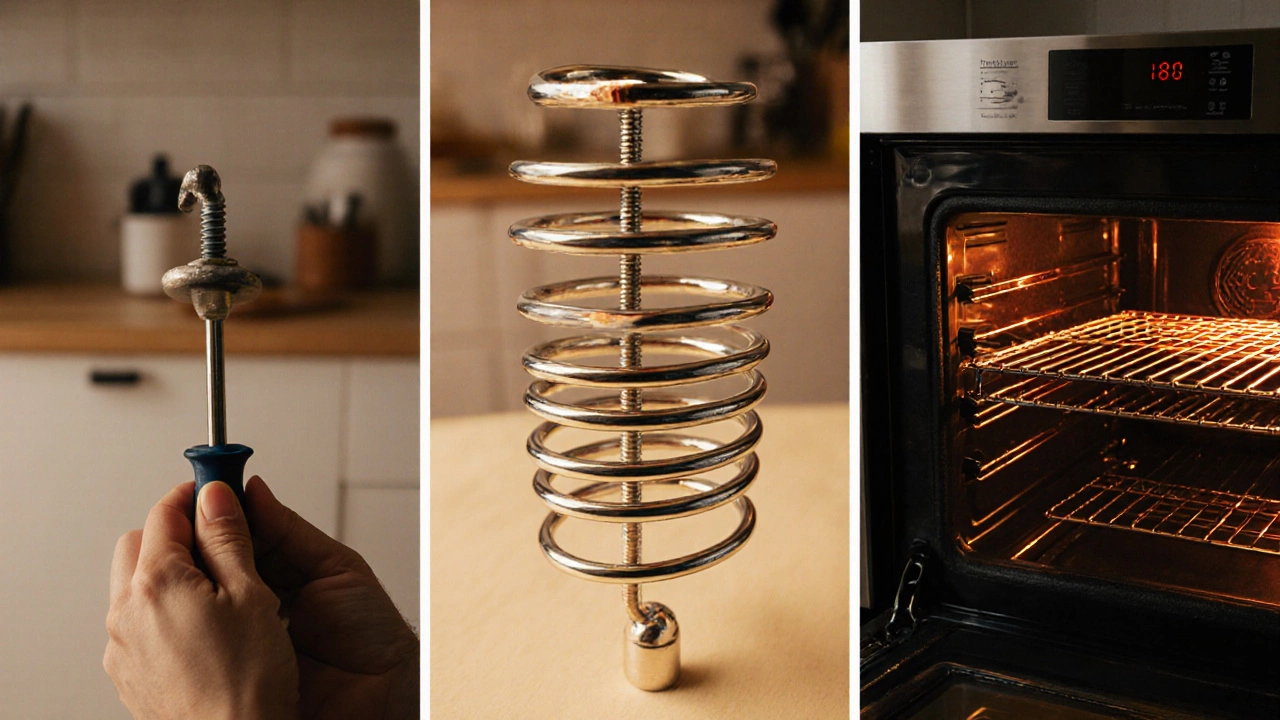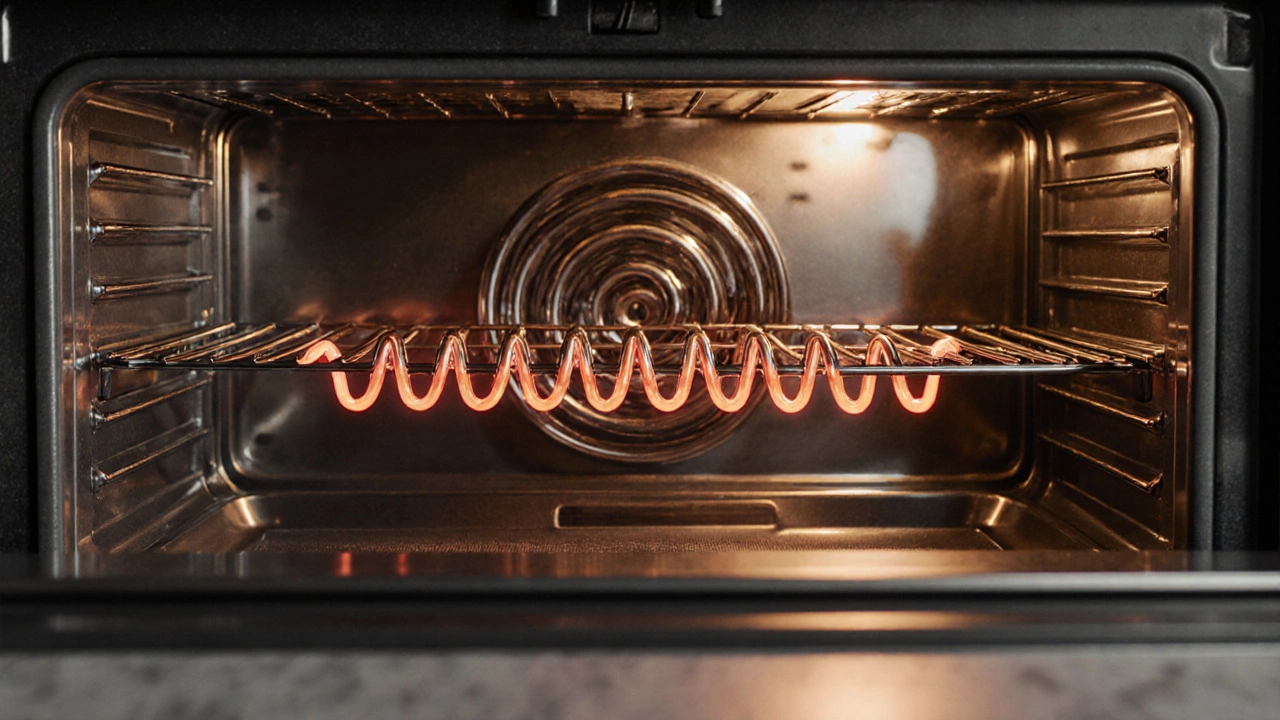When your oven suddenly refuses to heat, the most common culprit is the oven heating element - a long, metal coil that glows red and radiates heat inside the oven cavity. It converts electrical energy into the high temperatures needed for baking and roasting.
How an Oven Heating Element Works
In an electric oven, electricity flows from the home’s mains into the appliance, passes through a circuit breaker or fuse, and finally reaches the element. The element’s resistance causes it to heat up, which in turn warms the air inside the oven. Most ovens have two separate elements - a bake element at the bottom for even heating, and a broil element at the top for high‑heat searing.
Typical Signs That the Element Is Blown
Before you start fiddling with wires, watch for these tell‑tale symptoms:
- The oven lights up but the temperature never climbs.
- Only the top or bottom part of the oven gets hot.
- A faint burnt smell when you turn the oven on.
- Visible cracks, black spots, or a broken wire on the element.
- The oven displays an error code related to “heating element” (check your manual).
If any of these pop up, the element is the most likely offender.
Quick Diagnostic Checklist
Use this short list to confirm the problem before you grab a multimeter:
- Turn the oven off and unplug it.
- Open the oven door and locate the element (usually a shiny coil at the bottom).
- Inspect it visually for breaks, discoloration, or bulging.
- Check the oven’s thermostat - a faulty thermostat can mimic a dead element.
- If everything looks okay, move on to electrical testing.
Testing the Element with a Multimeter
A multimeter lets you measure resistance. A healthy element typically reads between 20 and 40 ohms, depending on the model. Here’s how to test:
- Set the multimeter to the lowest resistance (Ω) range.
- Detach the element’s wiring harness - you may need a screwdriver to release the connector.
- Place one probe on each metal terminal of the element.
- If the needle swings to zero or shows infinite resistance, the element is blown.
When you get a reading within the spec range, the element is probably fine and the problem lies elsewhere (e.g., a damaged temperature sensor).

Checking Wiring and Power Supply
Sometimes the element itself is fine, but the wiring or the mains supply fails. Follow these steps:
- Verify the outlet provides the correct voltage (usually 220‑240V in NewZealand). Use the multimeter on the AC voltage setting and measure at the oven’s power cord.
- Inspect the electrical wiring inside the oven for loose connections or burnt insulation.
- Check the circuit breaker in your home’s fuse box - a tripped breaker will cut power to the oven.
When to Replace the Element
If visual inspection shows damage, the multimeter reads zero or infinite resistance, or the oven still won’t heat after confirming power and wiring, it’s time for a new element. Replacement parts are usually listed by model number on the oven’s rating plate (usually inside the door frame).
Step‑by‑Step Replacement Guide
Replacing an element is a straightforward DIY job if you’re comfortable working with electricity. Here’s the process:
- Safety first: Unplug the oven and turn off the relevant circuit breaker.
- Remove the oven racks and any loose debris from the floor of the oven.
- Locate the screws or clips holding the element in place. Most bake elements have two screws at the ends.
- Unscrew the element and gently pull it out, taking care not to damage the surrounding insulation.
- Disconnect the wiring harness. Some ovens use a push‑in connector; press the release tab and pull the plug.
- Insert the new element, align the mounting holes, and tighten the screws.
- Reconnect the wiring harness, ensuring a snug fit.
- Replace the oven racks, close the door, plug the oven back in, and restore the circuit breaker.
- Run a quick test: set the oven to 180°C (350°F) and watch the element glow red within a few minutes.
If the new element lights up and the oven reaches temperature, you’ve solved the problem.

Preventive Tips to Extend Element Life
- Avoid overheating: Use the oven’s recommended temperature ranges and never exceed the max setting.
- Keep the oven clean: Food splatters can cause hotspots that stress the element.
- Don’t use the oven for long broil sessions more than necessary - the broil element runs at higher temperatures.
- Check the door seal periodically; a leaky seal forces the oven to work harder and can shorten element life.
Comparison Table: Symptoms of a Bad Element vs Other Oven Issues
| Symptom | Likely Cause | Typical Fix |
|---|---|---|
| No heat at any temperature | Blown oven heating element | Replace element |
| Heat only from the top | Failed broil element or broken thermostat | Replace broil element or thermostat |
| Temperature fluctuations | Faulty temperature sensor | Replace sensor |
| Oven won’t turn on at all | Tripped circuit breaker or faulty power cord | Reset breaker or replace cord |
| Short cycling (on/off quickly) | Bad thermostat or control board | Replace thermostat or board |
Frequently Asked Questions
Can I use a regular screwdriver to remove the element?
Yes, most oven elements are secured with standard Phillips or flat‑head screws. Just make sure the oven is unplugged before you start.
How long does an oven element typically last?
In normal use, a good quality element can last 5‑10 years. Frequent overheating or a faulty thermostat can cut that lifespan dramatically.
Do I need a professional to test the element with a multimeter?
No, the test is simple: disconnect the element, set the meter to resistance, and check the reading. Just follow safety steps and you’ll be fine.
What if the new element won’t glow after installation?
Double‑check the wiring connections and the circuit breaker. A loose connector or a tripped breaker are the most common oversights.
Is it safe to run the oven without the element in place?
Never. Operating the oven with a missing element can cause the control board to overheat and create a fire hazard.

I am an expert in the services industry with a focus on appliance repair. My passion lies in understanding how things work and educating others in simple, engaging ways. This enthusiasm fuels my writing, where I delve into topics around appliance maintenance and troubleshooting. I aim to make these subjects clear and accessible to all readers.